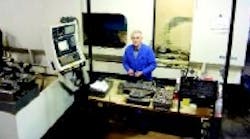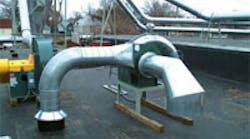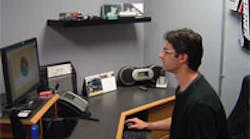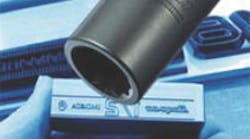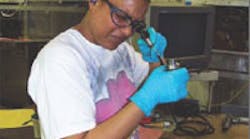Eric Reutimann calls his creepfeed grinding operations "abrasive machining."
Creepfeed grinding makes short work of turbine blade "fir trees."
Multipiece, guillotine-type holding fixtures boost blade grinding production at Form Grind.
Eric Reutimann, owner of Spectra-Tech in Hanover Park, Ill., refers to his creepfeed-grinding operation as "abrasive machining," and he does so with good reason. Creepfeed grinding, in some instances, easily removes 0.200 to 0.300 in. of stock in two or three passes — roughing between 0.100 and 0.150-in. deep, then running subsequent finish passes — to complete turbine-blade part features in hardened materials and, typically, with one setup. Reutimann also says creepfeed grinding eliminates the multiple operations involved with using other processes such as milling and broaching.
Often, shops mill a part in the soft state, heat treat and finish grind it to size. "But the result is usually the introduction of distortion, perhaps from heat treating, that necessitates additional milling and regrinding just to get the proper part flatness," says Reutimann. In creepfeed grinding, parts can be ground to finish in the hardened state on one machine.
Creepfeed grinding wheels can be shaped like broaching tools but are far less expensive to use, Reutimann says. Broaches require periodic resharpening that can be expensive and can lead to variations in part tolerances and quality, and broaching tools are expensive to replace when they break. Creepfeed grinding wheels are reshaped and dressed constantly, so they provide consistent repeatability, he adds.
However, abrasive machining takes a powerful, rigid and accurate grinder with above average repeatability. Reutimann uses Magerle FPA creepfeed grinders from United Grinding Technologies (www.grinding.com) and says it is much more versatile than a 1-in.-diameter wheel on a smaller grinder. With the Magerles, he is running 8-in.-diameter wheels and using 110 hp. That much horsepower demands rigidity to eliminate vibration and flaws, and the Magerles' hydrostatic guideways and robust constructions provide such rigidity for resolutions as tight as 0.000040 in.
Like Spectra-Tech, three other shops that specialize in aerospace parts also rely on Magerle creepfeed grinders. Form Grind Corp. of Rancho Santa Margarita, Calif., has 16 Magerles, nine FPA models and seven MFP CNC machines, that it uses for gas turbine blades, which account for about 70 percent of the shop's business.
Root serration profiles, known as fir trees, on these turbine blades must be held within ±0.0005 in., and according to Gary Treichler, vice president and general manager at Form Grind, the Magerles easily hold tolerances of ±0.0002 in.
The shop arranges blades in multipart, guillotine-type fixtures, each of which hold 12 blades by clamping on their airfoils. The machine uses 16-in.-diameter wheels, and runs two fixtures at a time for a total of 24 parts. This setup optimizes grinding wheel use, placing as much of the abrasive as possible against the part, and reduces cycle times.
At Abrasive-Form in Bloomingdale, Ill., company CEO Ken Kummer says his 20 Magerles plunge their formed grinding wheels to full depth into workpieces to produce finished parts in single passes. Besides fast cycle times, high repeatability and close tolerances, the grinders allow Abrasive-Form to machine super alloys as well as hardened materials, leaving superior surface finishes with essentially burr-free edges. A large portion of the shop's work is aerospace, and its creepfeed grinders routinely hold critical tolerances to meet specific customer Cpk numbers.
Kummer's Magerles sport factory-designed extended column heights for the flexibility to tackle long turbine blades. "Tips on long turbine blades require special processing that only the Magerles can handle, and the alternatives would involve complex fixturing and CNC processing with parts laying on angles or their sides," he says.
The Magerle model MFP 160-50 at Moeller Aerospace Technologies in Wixom, Mich., runs two to three shifts per day depending on work loads. One of its primary jobs is root forms on turbine blades, and it grinds them two at a time, completing both sides of the parts in one fixturing.
Dan Moellering, president of Moeller Aerospace, says the blades typically weigh 35 to 40 pounds, but some are as heavy as 100 pounds, and lengths vary from 24 to 36 in. "We do root forms on the Magerle because of its accuracy, repeatability and heavy stock-removal capabilities," says Moellering. Moeller Aerospace uses its Magerles to remove 0.200 to 0.300 in. of stock per turbine blade.
